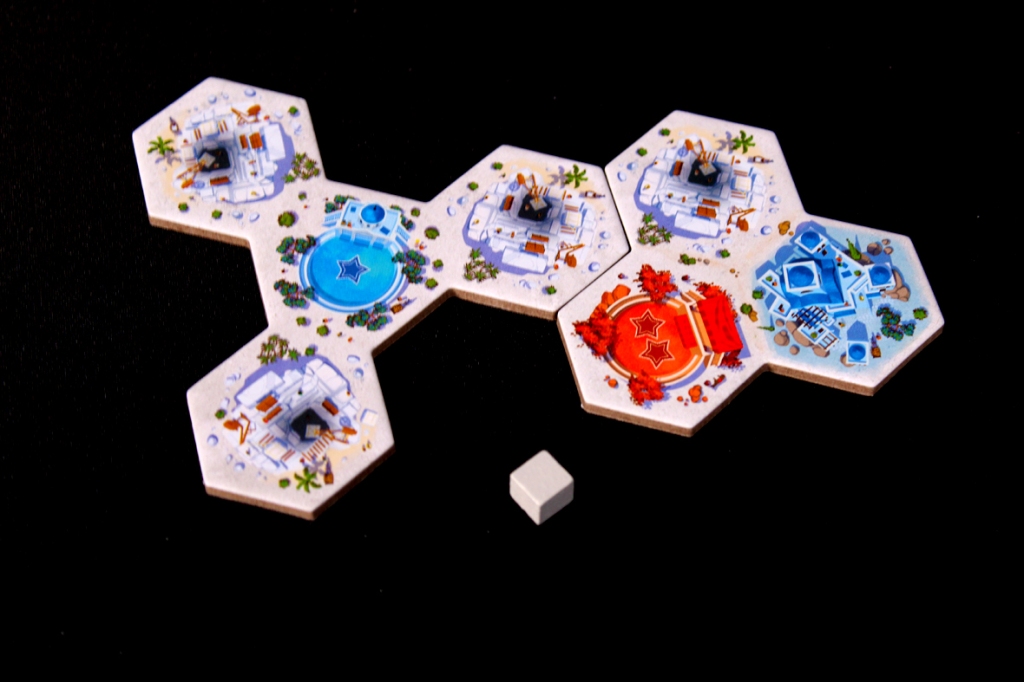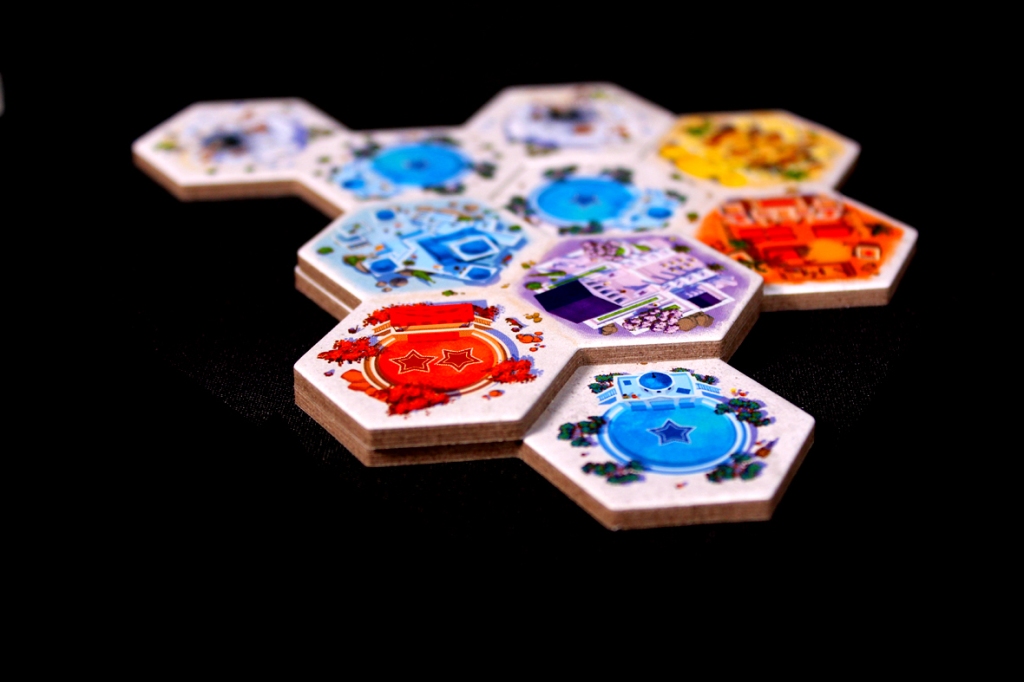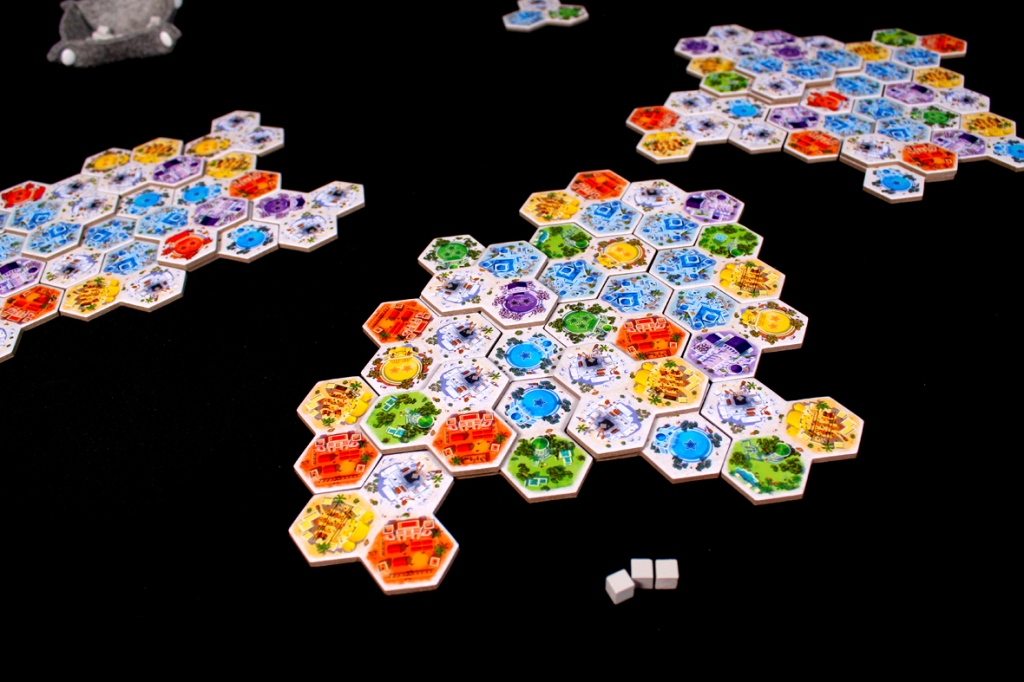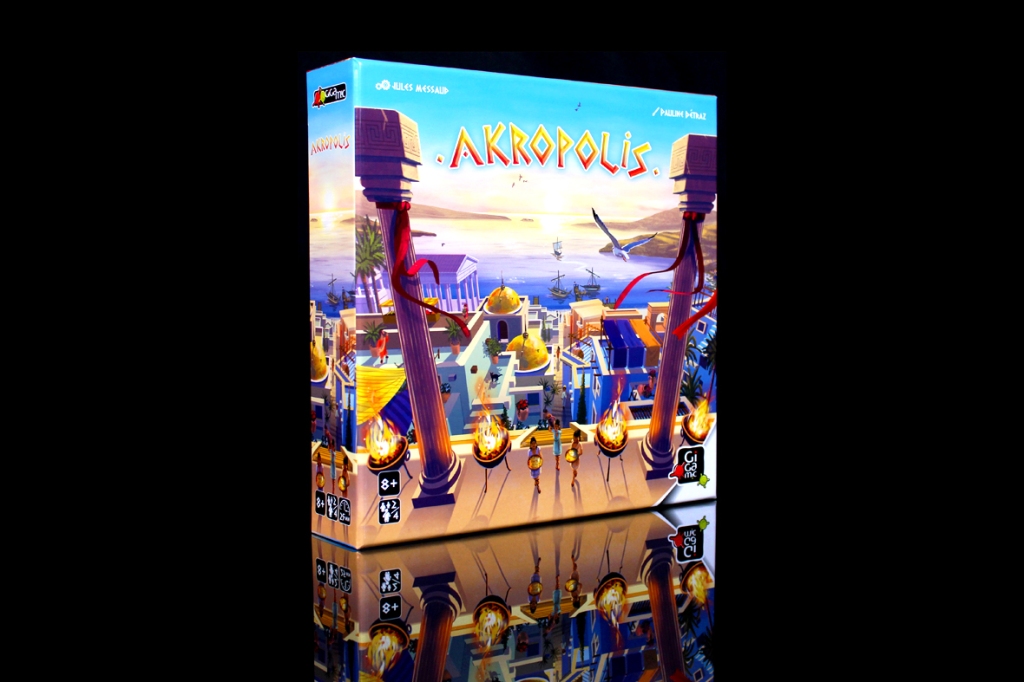
Base price: $30.
1 – 4 players.
Play time: 20 – 30 minutes.
BGG | Board Game Atlas
Buy on Amazon (via What’s Eric Playing?)
Logged plays: 24
Full disclosure: A review copy of Akropolis was provided by Hachette Boardgames.
This one’s one of those humorous cases where by the time I actually publish the review I’ll probably have added another eight plays or something; it’s an ongoing Board Game Arena favorite with a few of my close friends, so I usually have one or three games going at all times. I love that kind of thing, and I really appreciate how Board Game Arena has shot to the top of my list of online board game things primarily because of asynchronous play. Do I occasionally forget some of my strategies? Yes. Does it make some games (Yokai) impossible to play? Yes. Are there perfect undo functions on every game? Absolutely not. But you take what you can get. So let’s see how Akropolis plays!
In Akropolis, players take on the roles of the most talented architects in Greece who seek to build beautiful cities and make a name for themselves through smart district placement. Each round, you’ll take turns taking tiles from a row (occasionally paying stones to take tiles from farther down the row). When you do, you can place them in your city to try and fulfill their conditions for scoring. However, that alone won’t earn you points! There are special scoring tiles that must be present in your city as well for your districts to not end up worthless. And you wouldn’t want that. As you continue to build, you might notice places where you can build on top of quarries (and existing districts) to take your city to new heights! Building on top of quarries can also earn you valuable stones. All that will determine how great your city is. Will you be named the greatest architect?
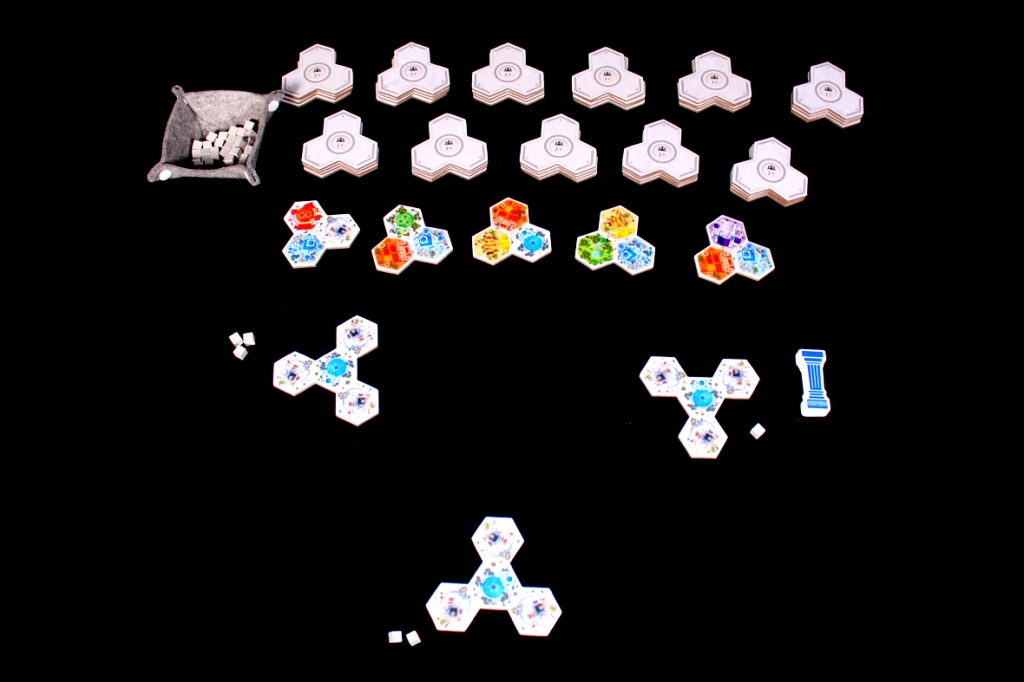
Contents
Player Count Differences
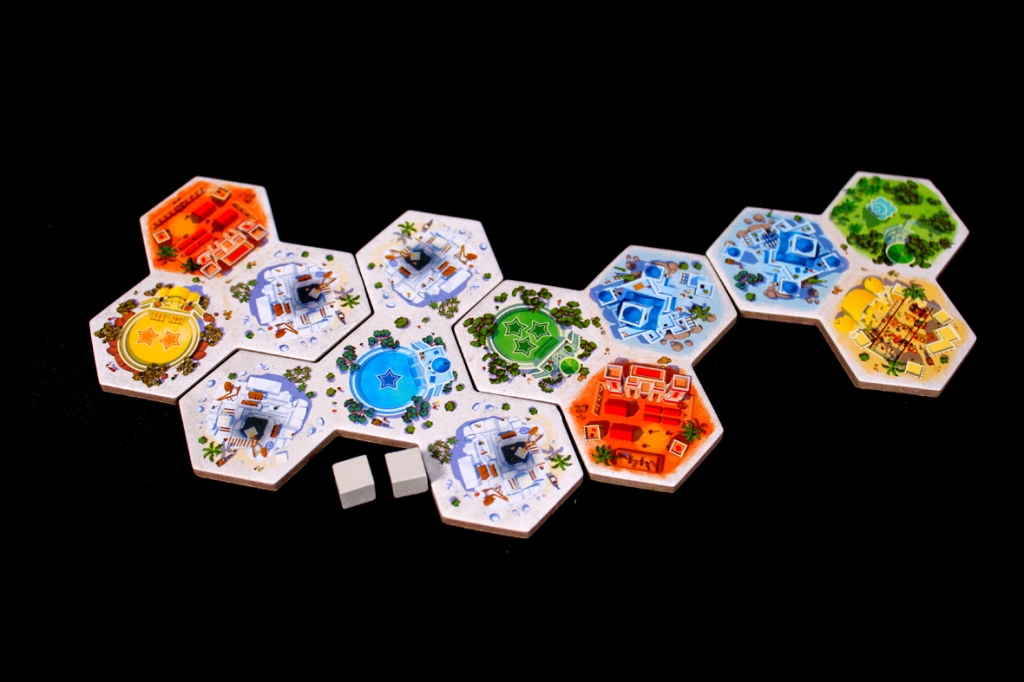
Akropolis is a drafting game, so there will be a few differences, here. Primarily, you’ll see that there’s always going to be more tiles in play at the start of a round with more players, mostly so that you can have a pretty good run of options no matter your player count. These tiles will be more expensive, as a result, so you may want to gather additional stones if you want to go for tiles farther back in the line. As with many drafting games, more options at the start means that the player who goes earliest usually has the best choice and the player who goes latest usually has their pick of the worst options, but I think that Akropolis deftly avoids that outcome by forcing players to pay more stones for tiles farther back, meaning that some “good” tiles may still be available for players. There are also more scoring tiles available at higher player counts, in an attempt to ensure that everyone has access to some, but that can cause some swing in the game (where one player might get even more of a certain scoring type, if they get lucky). I haven’t noticed that problem popping up in games too much, though; players are usually fairly responsive to that and play a bit defensively. I wouldn’t say, as a result, that I have a huge player count preference for this one; I’ve enjoyed it with fewer and with more players.
Strategy
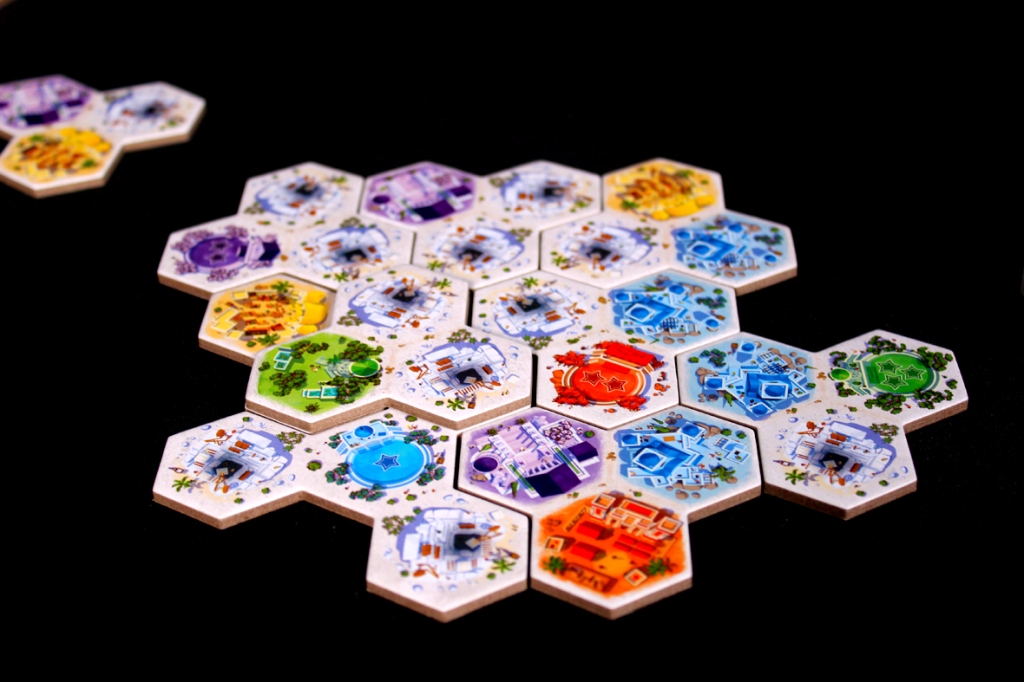
- Keep in mind that no matter how many tiles you get of a certain type, they’re worthless without their corresponding scoring tiles. This is kind of a comedic thing where you see someone get ten blues in a perfect row and then they realize they covered up the first blue scoring tile and didn’t get any others so now they just have a big 10 x 0 on their scoring sheet. I guess it’s funny for everyone else. Don’t let that be you!
- On the exact same symmetric note, you can have all the scoring tiles in the world and if you have no actual tiles of that color they’re just worth 0. It just ends up being a 0 x 10, which, thanks to the power of math, we know is still 0. Hoarding scoring tiles is a valid component of a larger strategy, but it’s not a strategy unto itself. Make sure you’re getting tiles that will actually use those scoring tiles.
- I tend to find purple to be one of the hardest tiles to score unless you’re specifically playing towards that outcome; your mileage may vary. They just require a lot of effort to become completely surrounded (unless you’re playing them on higher ground), and I often find that while they’re nice, I’d rather go after things that are easier to score. The one thing to note is that pretty much everyone feels that way, so you may be able to get a few of them if you’re lucky.
- Yellow tiles invalidate each other if they’re played adjacent to each other; keep an eye on that. This is the easiest one to forget, in my opinion, especially since blue wants to be part of a large contiguous area. If you end up invalidating them, well, that’s not ideal, since you (I assume) worked to plan to place them in the first place.
- More generally, just remember that for blue / yellow / purple / red there are conditions where they’re worth nothing. Go nuts with Parks, though. Parks have no such restriction on placement, which is absolutely wonderful. You can drop them pretty much anywhere (or use them to break up groups of yellow tiles). For the others, be mindful. Blue wants to be part of your largest group of blue, purple needs to be completely surrounded, red needs to have at least one open edge, and yellow can’t be next to other yellow tiles.
- You’re going to want to build up, eventually, so make space for that vertical ascension. One of the keys of Akropolis is that tiles on the second level are worth double and tiles on the third level are worth triple. Keep in mind that this does not apply to scoring tiles; just standard tiles, so they’re only worth something if you have the other tiles to score them with. But you also want to make space for the building up, specifically blank tiles so that you can gain additional stones. That’s the only way to get them!
- If you’re playing with variants, remember their scoring conditions and play to them! You can usually pick up a lot of points that way. The variants are interesting, partially because they usually inflate the score of a game by a fair amount by offering ways to make certain tiles worth double. This introduces a set of conditions where your tiles become worthless and a set of conditions where your tiles become twice as valuable. Try to go after the latter conditions, as you might guess.
Pros, Mehs, and Cons
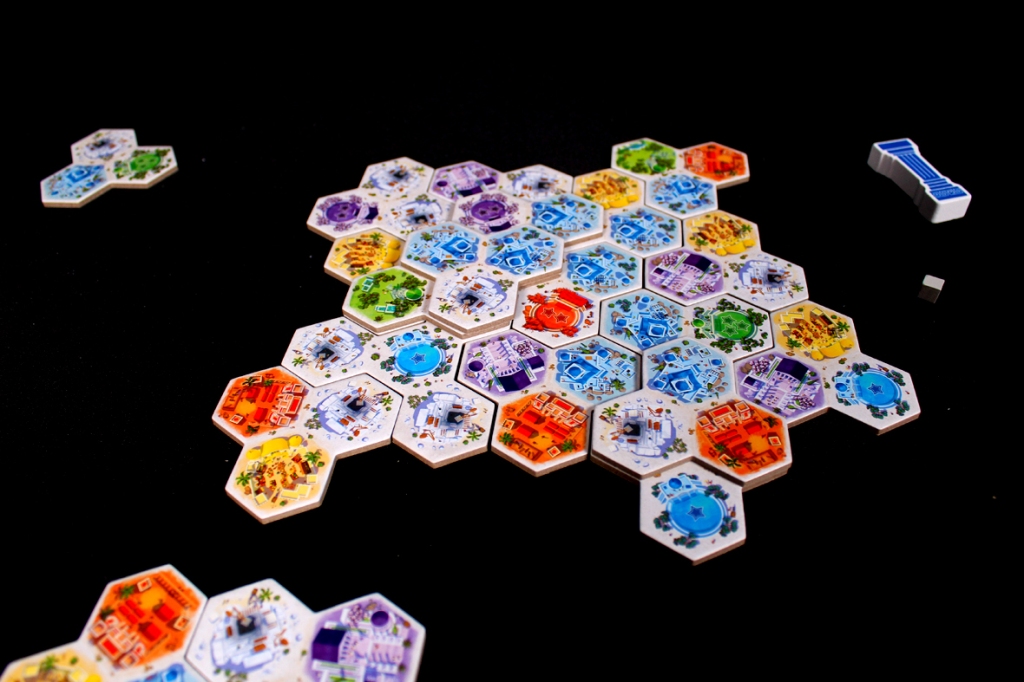
Pros
- I like the art style for this one! I think the white / gray of the tile borders contrasts really nicely with the bright and engaging colors on each tile, so it makes for a very fun and brightly-colored game. Y’all know how much I’m looking for that kind of thing. It also photographs well!
- I also appreciate how easy it is to teach. You’re just teaching basic drafting with some tile placement rules, which is great. I love how clever the game is despite its fairly simple structure. That’s solid design.
- The vertical building aspect is both fun and makes the game look more striking. I love it when gameplay and table presence overlap nicely. A bit of verticality goes a long way with games. But when you’re playing at a con or at a game night, that gets people’s attention! People love seeing games slowly build up. I mean, I do, and I’m people. But it’s also nice that, strategically, that’s what you want. It means that you’re actively trying to make the game look better in order to score more points.
- The game also plays pretty quickly! Definitely not a particularly long-feeling game; you get through the stacks quickly (and there are only 11 extra stacks). Plus, the individual turns aren’t too long; you just pick a tile and place it.
- Akropolis is definitely a nominee for my “great after-work games”, a growing and critical part of my collection. I generally pick these games based on how long they take to play and how much cognitive burden I have to take on to teach and learn the game. Akropolis is pretty low in both, but it’s a game I really enjoy playing with a wide variety of different players, so it ends up very easily sailing into this great after-work games set. I like that set a lot, especially lately.
- I enjoy the interplay between different tiles’ scoring conditions. You can’t prioritize everything. You have to choose which elements you want to go after and which you’re going to fall back on, and that might change and shift based on what your opponents are doing! It’s a very dynamic play space.
- I also really like that the tiles and their scoring tiles are separate, forcing you to try and prioritize both, to some degree. This makes the game particularly fun, since you can also then try to hold on to scoring tiles that other players need and potentially deprive them of big multipliers of points. That’s the ideal outcome, but most players usually manage to scrape a couple points here and there.
- The variant is interesting as well! I like that it adds ways to earn even more points with the various tiles, though it does inflate the score a lot. I wonder if that makes the game a bit swingier based on the luck of the tile draw, but I don’t have a lot of evidence either way.
Mehs
- Doing all the multiplicative scoring by hand really makes me miss BGA’s automatic (and constantly-updating) scoring. It’s really just me being lazy about math. I got spoiled by learning the game on BGA, where they’ll constantly update your score after every tile you’ve placed, so you know exactly where you stand the entire game.
Cons
- There are just enough tiles that having to sift through all of them based on your player count can be annoying. Learned this the hard way; a friend “accidentally” purloined my copy of Akropolis and then I had to switch from a 4-player game to a 3-player game for Photography Reasons and that took a while to make all the changes. Not really anything to be done about it, just something that caused me to sigh while I was setting up.
Overall: 8.75 / 10
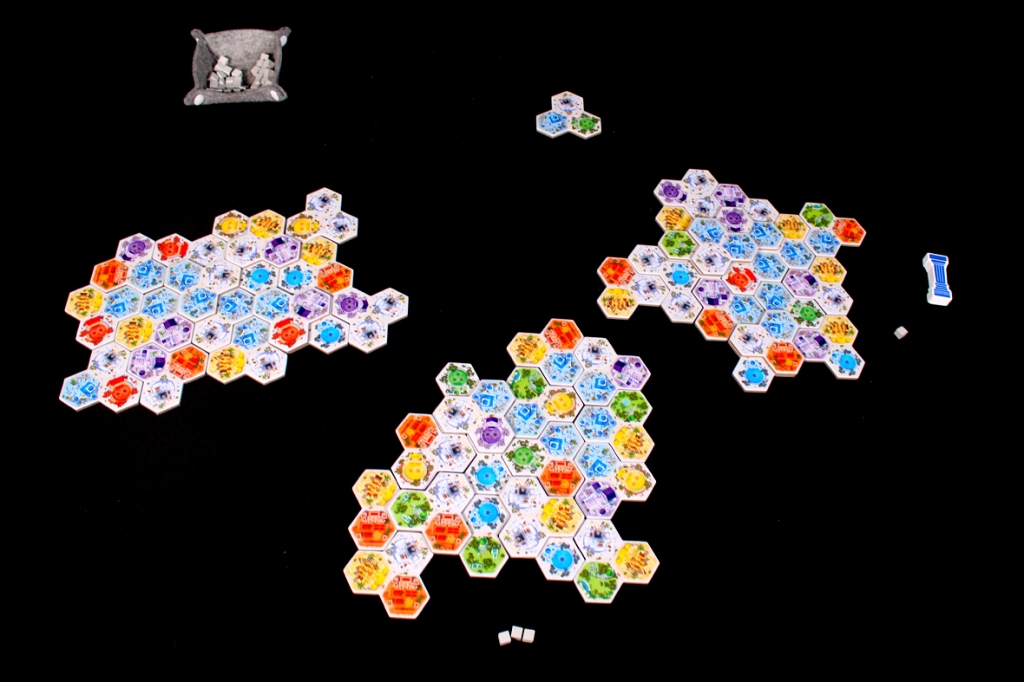
Overall, I’m a huge fan of Akropolis! I think Gigamic has outdone themselves with this one, as they’ve made something extremely approachable, tactically interesting, and visually engaging. The game fires on all cylinders, and I like that a lot. Of my tile-laying drafting games, I’ll admit that I’m slightly more partial to Cascadia (that might be my bias as a new resident), but I’m never complaining about being blessed with a wealth of games that are mechanically similar but unique and interesting in their own right. It’s a nice problem to have, so many great games. What makes Akropolis great is its balancing of aesthetic, mechanics, and strategy. I really like that element of verticality I’ve mentioned elsewhere. Stacking tiles is fun and I appreciate that Akropolis heavily rewards players who are able to build their cities to make that possible. Plus, that makes the game look better, which then does its own advertising at conventions. It’s brilliant, to some degree. Akropolis is also very simple to learn, which, fantastic! It’s one of a handful of games that I would highly recommend to folks who are newly getting into the hobby, which is an exciting place to be. I’ll be interested to see how it holds up over the upcoming years of play, but one thing’s for sure: Akropolis is going to be in my collection for a good while! I’d definitely recommend this one.
If you enjoyed this review and would like to support What’s Eric Playing? in the future, please check out my Patreon. Thanks for reading!
